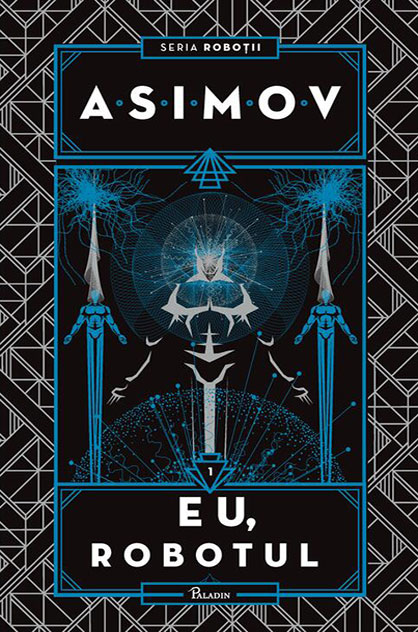- Rating: ★★★★☆
- Editura: Art, imprint Paladin
- Traducere: Antuza Genescu
- Pagini: 280
- Goodreads: Eu, Robotul
- Poate fi cumpărată de aici: https://www.editura-paladin.ro/info/carte/robotii-eu-robotul
Am citit „Eu, Robotul” de Isaac Asimov cu o curiozitate imensă, mai ales pentru că este o carte clasică atunci când vine vorba de știință și roboți. Deși nu este un roman cu o singură poveste, ci mai degrabă o colecție de povestiri legate între ele, am simțit că fiecare capitol are ceva special de spus despre relația dintre oameni și tehnologie.
Povestirile sunt prezentate prin ochii doctoriței Susan Calvin, o psiholoagă de roboți care povestește, de-a lungul carierei ei, întâmplări și experiențe legate de evoluția mașinilor inteligente. Susan mi s-a părut un personaj foarte interesant – rece și calculată la prima vedere, dar în același timp extrem de pasionată de ceea ce face. Este genul de persoană care nu caută neapărat apropierea oamenilor, dar înțelege roboții mai bine decât oricine. Prin ea, Asimov ne arată cât de complicată poate deveni relația dintre creatori și creațiile lor.
Am întâlnit și alte personaje care mi-au rămas în minte, cum sunt Donovan și Powell, doi ingineri simpatici și uneori ironici, care se tot lovesc de situații neprevăzute cu roboții. Mi-a plăcut dinamica dintre ei – aduc puțin umor într-o lume ce altfel ar părea rece și strictă. Fiecare aventură a lor arată cum celebrele „Trei Legi ale Roboticii” pot fi interpretate sau răstălmăcite în moduri surprinzătoare, ducând la probleme greu de rezolvat.
Ce m-a captivat a fost modul în care Asimov combină știința cu partea umană. Nu este doar vorba de roboți care execută ordine, ci despre dileme morale, despre limitele inteligenței artificiale și despre întrebarea: „Cât de mult putem controla ceea ce creăm?”. Povestirile nu sunt pline de acțiune explozivă, ci mai degrabă de tensiune psihologică și de jocuri de logică. Asta le face fascinante, dar recunosc că uneori au fost pasaje mai tehnice care m-au încetinit.
Per total, „Eu, Robotul” mi-a plăcut mult, dar nu pot să îi dau cinci stele pentru că mi s-a părut că uneori povestirile sunt mai seci și mai reci, mai concentrate pe teorie decât pe emoție. Totuși, este o carte care merită citită, mai ales pentru felul în care Asimov a reușit, cu zeci de ani în urmă, să prevadă probleme pe care și noi le discutăm astăzi: inteligența artificială, limitele etice și frica de a pierde controlul.
Pentru mine, lectura a fost ca o discuție între trecut și viitor. Chiar dacă roboții din carte par astăzi un pic învechiți, ideile lui Asimov sunt la fel de actuale. Iar asta este dovada clară că avem în față o operă clasică, care încă mai are ceva de spus cititorilor moderni.


I, Robot – Isaac Asimov (Robot, #1)
I read „I, Robot” by Isaac Asimov with immense curiosity, especially because it’s considered a classic when it comes to science and robots. Although it’s not a novel with a single storyline, but rather a collection of interconnected short stories, I felt that each chapter had something special to say about the relationship between humans and technology.
The stories are presented through the eyes of Dr. Susan Calvin, a robopsychologist who recounts, over the course of her career, events and experiences connected to the evolution of intelligent machines. I found Susan to be a very interesting character—cold and calculating at first glance, but at the same time extremely passionate about what she does. She’s the type of person who doesn’t necessarily seek closeness with people, but understands robots better than anyone. Through her, Asimov shows us how complicated the relationship between creators and their creations can become.
I also came across other memorable characters, such as Donovan and Powell, two witty and sometimes ironic engineers who constantly run into unexpected situations with robots. I enjoyed the dynamic between them—they bring a touch of humor into a world that would otherwise seem cold and rigid. Each of their adventures shows how the famous “Three Laws of Robotics” can be interpreted or twisted in surprising ways, leading to problems that are difficult to solve.
What captivated me was the way Asimov combines science with the human side. It’s not just about robots carrying out orders, but about moral dilemmas, the limits of artificial intelligence, and the question: “How much control do we really have over what we create?” The stories aren’t filled with explosive action, but rather with psychological tension and logical puzzles. That makes them fascinating, though I admit that at times the more technical passages slowed me down.
Overall, I really enjoyed „I, Robot”, but I can’t give it five stars because I felt that some of the stories were a bit dry and cold, more focused on theory than emotion. Still, it’s a book worth reading, especially for the way Asimov managed, decades ago, to anticipate issues that we’re still discussing today: artificial intelligence, ethical boundaries, and the fear of losing control.
For me, the reading felt like a dialogue between past and future. Even though the robots in the book now seem a little outdated, Asimov’s ideas are just as relevant. And that is clear proof that we’re dealing with a classic work, one that still has something to say to modern readers.


Lasă un răspuns